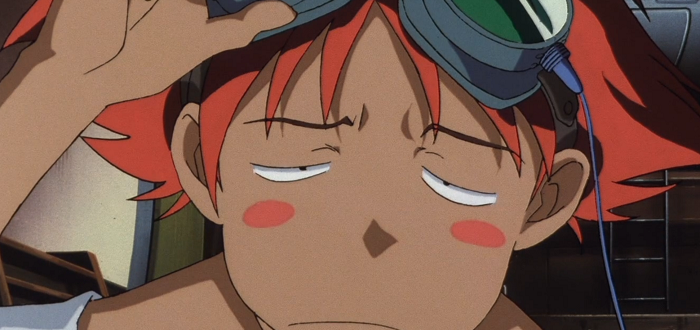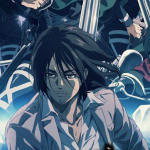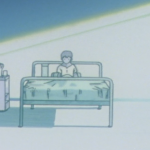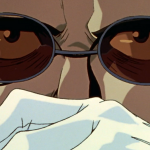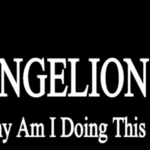Adios, Cowboy: Review 12 – Jupiter Jazz Part 1
Even for a high school band dropout like yours truly, it is now obvious that Cowboy Bebop defines its storytelling through musical conventions. The show is built on motifs, repetition, experimentation, patterns, and variations on a theme. Simultaneously, it will lean in toward emotional affect and a sense of bleeding cool at the expense of presenting something cohesive or easy to understand. To ask why, is to invite the show to fire back with the apocrypha of so many teachers who claimed to ace philosophy exams by answering, “Why not?”
To wit, Jupiter Jazz begins with yet another shaman-figure auguring the plot. The fact that we’ve seen this lead-in in previous episodes puts me in mind of Ghost in the Shell: Stand Alone Complex. Where SAC would use a title card to tell the audience if a given story was a “stand alone” episode or a “complex” part of the Laughing Man arc, I think Bebop’s mystical invocation might be a cagier variation on the theme. I wonder if this approach landed better in the 90s than it does today. The wise old indigenous person seeing visions in the smoke seems a bit gimmicky to my modern sensibilities. Representation is good, don’t get me wrong. Representation rooted in stereotypes, meh.
As was the case in Ballad of Fallen Angels, the mere mention of something from Spike’s past, in this case the name of his past lover, Julia, sends him running to Callisto. Never mind that Faye has left the Bebop and robbed Spike and Jet of everything they had. Never mind that Ed says Blue Crow, the town on Callisto where Julia is alleged to be, is a town without any women. Never mind that Jet sees this as yet another fool’s errand. Everybody on the Bebop seems to know that chasing Spike’s past leads to nothing but trouble. So naturally, everybody will find a way to dive begrudgingly into the mix.
Because this is part one of a two-part episode, I want to reserve specific comments on if the story works until after I’ve seen part two. In the meantime, let’s scratch at the surface of this episode’s setting: Callisto. As moons go, Callisto is a toilet. I dare say it is the worst place the audience has seen in Cowboy Bebop, even worse than Earth. Callisto looks like a company town that was abandoned mid-construction. Across planets, moons, space colonies, and space stations, Callisto is the first place that shows external life support equipment as a part of daily life. Most people on Callisto wear full facemasks connected to portable air scrubbers on their backs. One of the episode’s anonymous goons says that the only things on Callisto are broken down cars, stale bread, and rancid booze.
Seeing engineered privation (I suspect Callisto is the garbage dump of the Sol system) of this extent invites some thoughts on how Cowboy Bebop imagines our future. Within the staples of Western science fiction, the decades between the Cold War’s détente and the September 11th attacks imagined the world beyond the superpowers of the west and east. If these stories are ranked by idealism, the likes of Star Trek TNG sits at one end of the spectrum. Stories of this sort are generally optimistic, showing futures where hegemonic liberalism has ended poverty, social inequity, and solved all of society’s ills. One finds Shadowrun at the other end of the spectrum. That is a world where nation states, writ large, faltered in the face of rising corporate temporal power. Jupiter Jazz’s first half leaves me many thoughts on where Bebop lands on this above spectrum. But first, a word on cliffhangers from Critic Adam.
I know the writing wants me to get worked up about Spike being shot and left for dead. Likewise, I know I am supposed to be worried that Faye is about to get raped by Gren following the revelation that Gren is an intersex person. To both points I say the following in the fashion of George Oscar Bluth, “COME ON!? YOU THINK THE GUY WHO WROTE 18,000 WORDS ABOUT HALF A TV SHOW IS GOING TO FALL FOR THAT? COME ON!?”
There’s no way Spike’s shooting isn’t a lazy contrivance. There are 26 episodes in the series. His name is plastered in the opening credits. Spike has plot armour. The idea that Spike might be dead is as preposterous as everybody dying at the end of Toys in the Attic.
Here’s my lesson for you, kids, don’t try to build tension by potentially killing off your main character less than half way through the story. Give your audience a little bit more credit than that. Even in the 90s we had the internet, and we could have used Alta Vista to figure out how many episodes there were in Cowboy Bebop.
Then there’s Gren. I could make a whole big deal about this particular variation on transphobia, instead I’m going to award it a ribbon for “stupidest power move” and get on with my life. I am disappointed by this, but I am not surprised. Even Star Trek TNG did a gay panic episode in the 90s when Dr. Crusher started dating a Trill. Contemporary writers still pull shitty moves like framing non-heteronormativity as backstory for rape, so let’s consider it a lesson in how far we haven’t come.
Returning focus to where this show sits within the spectrum of futures, let me propose a question: what if Cowboy Bebop is “space status quo”, or at least what passed for the 90s status quo, and not “space jazz”? It’s clear that the solar system is built around Mars as a single superpower. Characters repeatedly say all of the best things come from Mars, and that a person can have anything they want on Mars. Even Mars’ hyperspace gates present as ornate compared to the utilitarian gates elsewhere in the system.
If Mars is situated as the single superpower and an economic core (i.e. America in the 90s), Callisto becomes an analogue for the 20th century’s developing nations. Ship out the garbage from Venus and Mars to Callisto as a means of economic control. Build cities on Callisto only so long as it is profitable for the parent company. Who cares what happens “over there” because there is an entire asteroid belt and a lot of empty space between the 4th world problems of Mars (see what I did there) and the people kept out of sight and out of mind on a Jovian moon.
I know it is tempting to see something like the Red Dragon Syndicate as one of the mega-corporations from Shadowrun and assume Bebop is working within a mood of corporate nihilism. But given what we’ve seen, Red Dragon would be hard pressed to measure-up to the likes of Robocop’s OCP. Granted Red Dragon has goons and ships. From where I sit they don’t leverage any power over the affairs of the solar system. Based on what we’ve seen they are closer to the DiMeo crime family than OCP. Absent the polar exemplars of liberal utopias or corporate nightmares, Cowboy Bebop reads as a projection of the contemporary into space. Much like Babylon 5, Bebop is expanding on who we were in the 90s within a setting where familiar patterns are free to replicate and propagate.
Bearing all that in mind, here’s a question I can’t quite answer, at least not yet. Is this projection of future status quo something that is lazy on the part of the authors? Or is it an attempt to confront the fact that for people who lived through the tail-end of the cold war, late-stage capitalism feels like a monolith unto itself? Is Bebop writing a future filled with freelance policing and exploitation of economic peripheries because deep down we don’t feel like we can ever get away from those systems? Perhaps we even need those systems.
To quote part one of Jupiter Jazz, to be continued.

